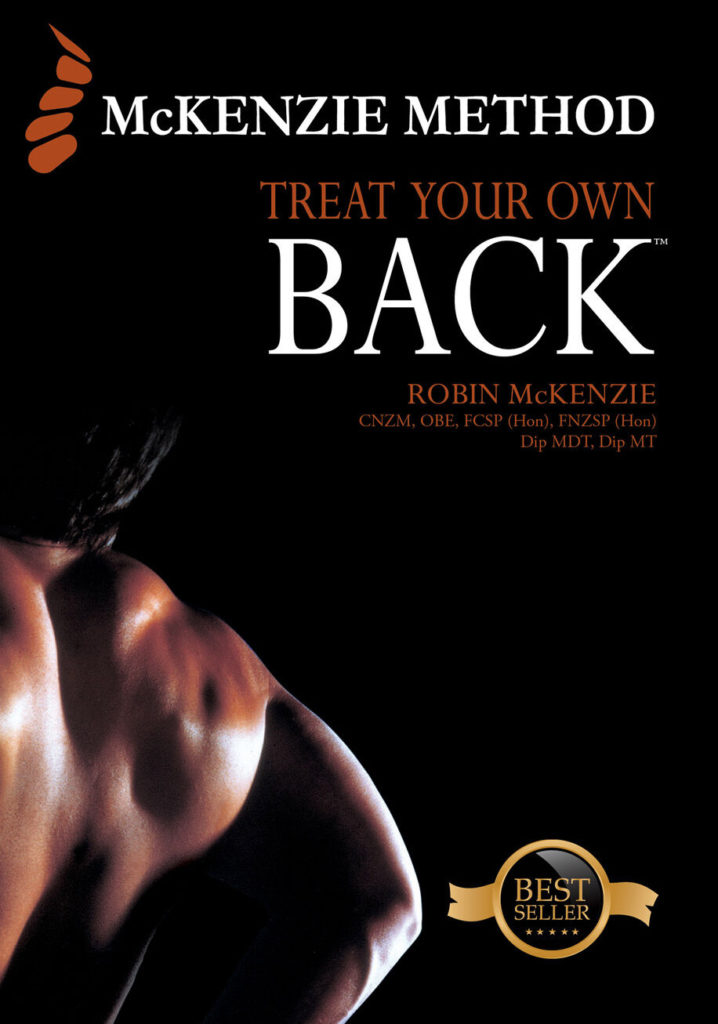STRENGTH SENSEI BOOKSHELF
Treat Your Own Back
A look at one of the most popular self-help books for preventing and treating lower back pain
For those looking for a quick fix for acute or chronic back pain, physical therapist Robin McKenzie offers several simple, at-home exercises that may be exactly what you need. That is the promise of his book, Treat Your Own Back. Does it deliver?
Before taking a closer look at McKenzie’s approach to back pain, consider that Treat You Own Back is one of the bestselling books on lower back pain, ever. First published in 1980, it sold over four million copies and has been translated into 18 languages. It is now in its 9thedition.
The book starts with how McKenzie, a physical therapist from New Zealand, discovered his treatment method by accident. In 1956, a back pain patient complained of lower back pain on his right side that extended to his knee. He received no relief from three weeks of conventional physical therapy treatments.

During one visit, McKenzie told the patient to go to his treatment room and lie face down on his treatment table. This table had the front end elevated for a previous patient but had not been adjusted to lay flat. After five minutes of the patient resting with his upper back hyperextended, McKenzie came into the room and was concerned that resting in this position would make his patient’s condition worse. However, his leg pain disappeared, and his lower back pain moved to the center of his lower back at waistline level. The next day, McKenzie positioned him on the treatment table in the same hyperextended position, and his other symptoms disappeared.
One key characteristic of the McKenzie method is that it may create this “centralization phenomenon,” such that the pain moves to the center of the spine. McKenzie says that when this occurs, his treatment methods are especially effective.

If you want a quick summary of McKenzie’s approach to back pain and how it compares to other treatment methods, Chapter 1 discusses eight myths about back pain, discussing topics such as the value of spinal manipulation, ultrasound, various electrical therapies, and the role of exercise with those suffering from back pain.
From there, McKenzie will guide you step-by-step through his system. Included is information about using proper posture and lifting techniques to help prevent back pain from occurring in the first place. He will even tell you how to sneeze properly to avoid aggravating existing back pain! Although a self-help book, McKenzie recommends that if you do not receive benefit from applying the methods in this book, consult with a qualified McKenzie clinician.
You would think that a method so popular would eventually attract the attention of the scientific community, and it has. An extensive meta-analysis of the McKenzie Method was published in the May 31, 2018, issue of the Journal of Orthopaedic and Sports Physical Therapy (Volume 48, Issue 6). Its title is “Effectiveness of the McKenzie Method of Mechanical Diagnosis and Therapy for Treating Low Back Pain: Literature Review With Meta-analysis.”
This review focused on 17 studies.The authors found that there was “moderate- to high-quality evidence” that in patients with acute lower back pain, the McKenzie Method “was not superior to other rehabilitation interventions for reducing pain and disability” and that “other intervention methods might offer a similar benefit.”
There is also concern that the McKenzie Method may be contra-indicated for some individuals. For example, lumbar spinal stenosis involves a narrowing of the spinal canal in your lower back that can irritate the nerves in your spinal cord. Alfred O. Bonati, MD, is the founder of the Bonati Spine Institute, headquarters in Hudson, Florida. The Institute specializes in laser-assisted spinal surgery and has treated over 70,000 patients. In a January 31, 2021, interview with medical writer Lorra Garrick (scarysymptons.com), Bonati warned that back extension exercise could cause more damage to these nerves or the spinal cord.
For some, Robin McKenzie’s approach to preventing and treating back pain may be effective. But again, “for some.” The best approach is to consult with a qualified medical professional in this field to see if this type of program is appropriate for you.
[You can purchase Treat Your Own Back by Robin McKenzie through Amazon.com.)
